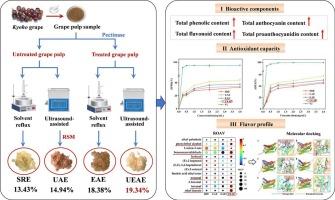Effect of ultrasound-assisted extraction combined with enzymatic pretreatment on bioactive compounds, antioxidant capacity and flavor characteristics of grape pulp extracts
IF 9.7
1区 化学
Q1 ACOUSTICS
引用次数: 0
Abstract
To obtain grape pulp extracts with high quality, this study optimized the ultrasound-assisted extraction process using the response surface methodology, and further investigated the effect of solvent reflux extraction and ultrasound-assisted extraction with or without the enzymatic pretreatment on bioactive compounds, antioxidant capacity and flavor characteristics of grape pulp extracts. Results indicated that the optimal extraction conditions for ultrasound-assisted extracts of grape pulp (UAE) were 16 min ultrasonic time, 70 % ultrasonic amplitude, and 28 °C ultrasonic temperature, resulting in an extraction yield of 14.94 %, a total phenolic content of 14.38 mg GAE/ g, and a total flavonoid content of 2.98 mg RE/g. Moreover, grape pulp extracts prepared by ultrasound-assisted extraction combine with enzymatic pretreatment (UEAE) had highest bioactive compounds content and exhibited the best antioxidant capacity among the four grape extracts. There were significant differences in flavor among four grape extracts, and the aroma characteristics of UEAE were significantly improved in comparison to other grape extracts. Molecular docking revealed that the stable interactions of these aroma compounds and olfactory receptors were mainly attributed to hydrogen bonding and hydrophobic effects. These findings revealed that ultrasound-assisted extraction combined with enzymatic pretreatment not only enhanced the bioactive compounds content, but also remarkably improved the flavor characteristics of grape pulp extracts. This study offers valuable insights into the extraction and utilization of grape extracts.

超声辅助提取联合酶处理对葡萄果肉提取物生物活性成分、抗氧化能力和风味特性的影响
为获得高品质的葡萄果肉提取物,本研究采用响应面法对超声辅助提取工艺进行了优化,并进一步研究了溶剂回流提取和超声辅助提取加酶前处理或不加酶前处理对葡萄果肉提取物生物活性成分、抗氧化能力和风味特性的影响。结果表明,超声辅助提取葡萄浆的最佳工艺条件为超声时间16 min,超声振幅70%,超声温度28℃,提取率为14.94%,总酚含量为14.38 mg GAE/ g,总黄酮含量为2.98 mg RE/g。此外,超声辅助提取联合酶处理(UEAE)法制备的葡萄果肉提取物生物活性物质含量最高,抗氧化能力最好。4种葡萄提取物风味差异显著,其中UEAE的香气特性较其他葡萄提取物有显著改善。分子对接表明,这些香气化合物与嗅觉受体的稳定相互作用主要是由于氢键和疏水效应。综上所述,超声辅助提取结合酶处理不仅提高了葡萄果肉提取物的生物活性成分含量,而且显著改善了其风味特性。本研究为葡萄提取物的提取和利用提供了有价值的见解。
本文章由计算机程序翻译,如有差异,请以英文原文为准。
求助全文
约1分钟内获得全文
求助全文
来源期刊

Ultrasonics Sonochemistry
化学-化学综合
CiteScore
15.80
自引率
11.90%
发文量
361
审稿时长
59 days
期刊介绍:
Ultrasonics Sonochemistry stands as a premier international journal dedicated to the publication of high-quality research articles primarily focusing on chemical reactions and reactors induced by ultrasonic waves, known as sonochemistry. Beyond chemical reactions, the journal also welcomes contributions related to cavitation-induced events and processing, including sonoluminescence, and the transformation of materials on chemical, physical, and biological levels.
Since its inception in 1994, Ultrasonics Sonochemistry has consistently maintained a top ranking in the "Acoustics" category, reflecting its esteemed reputation in the field. The journal publishes exceptional papers covering various areas of ultrasonics and sonochemistry. Its contributions are highly regarded by both academia and industry stakeholders, demonstrating its relevance and impact in advancing research and innovation.
 求助内容:
求助内容: 应助结果提醒方式:
应助结果提醒方式:


